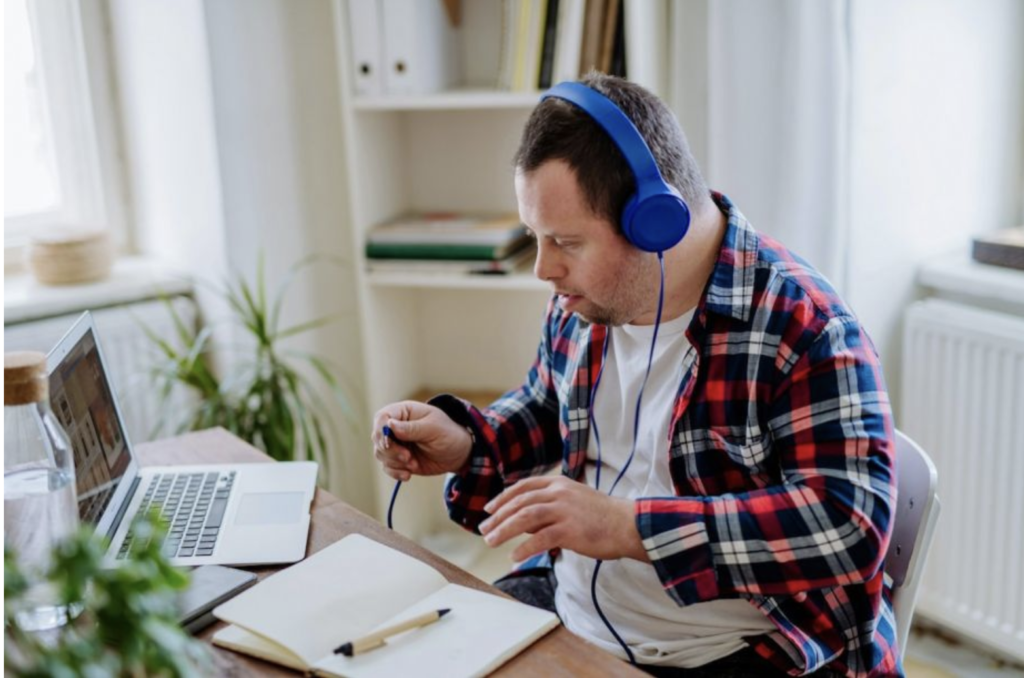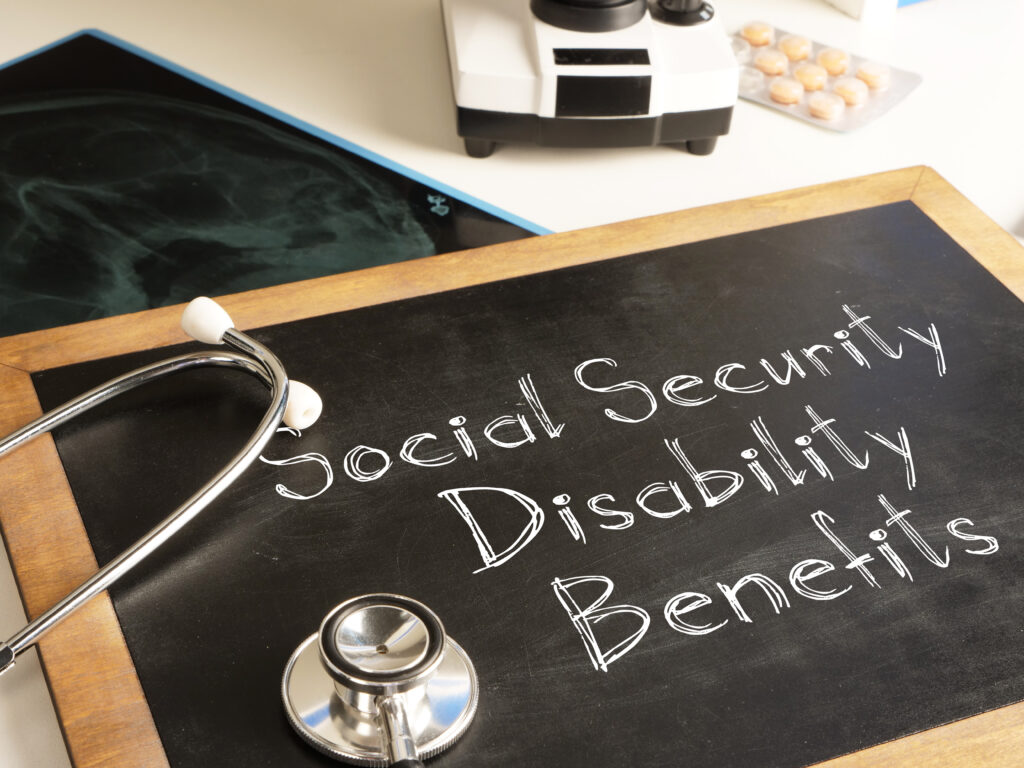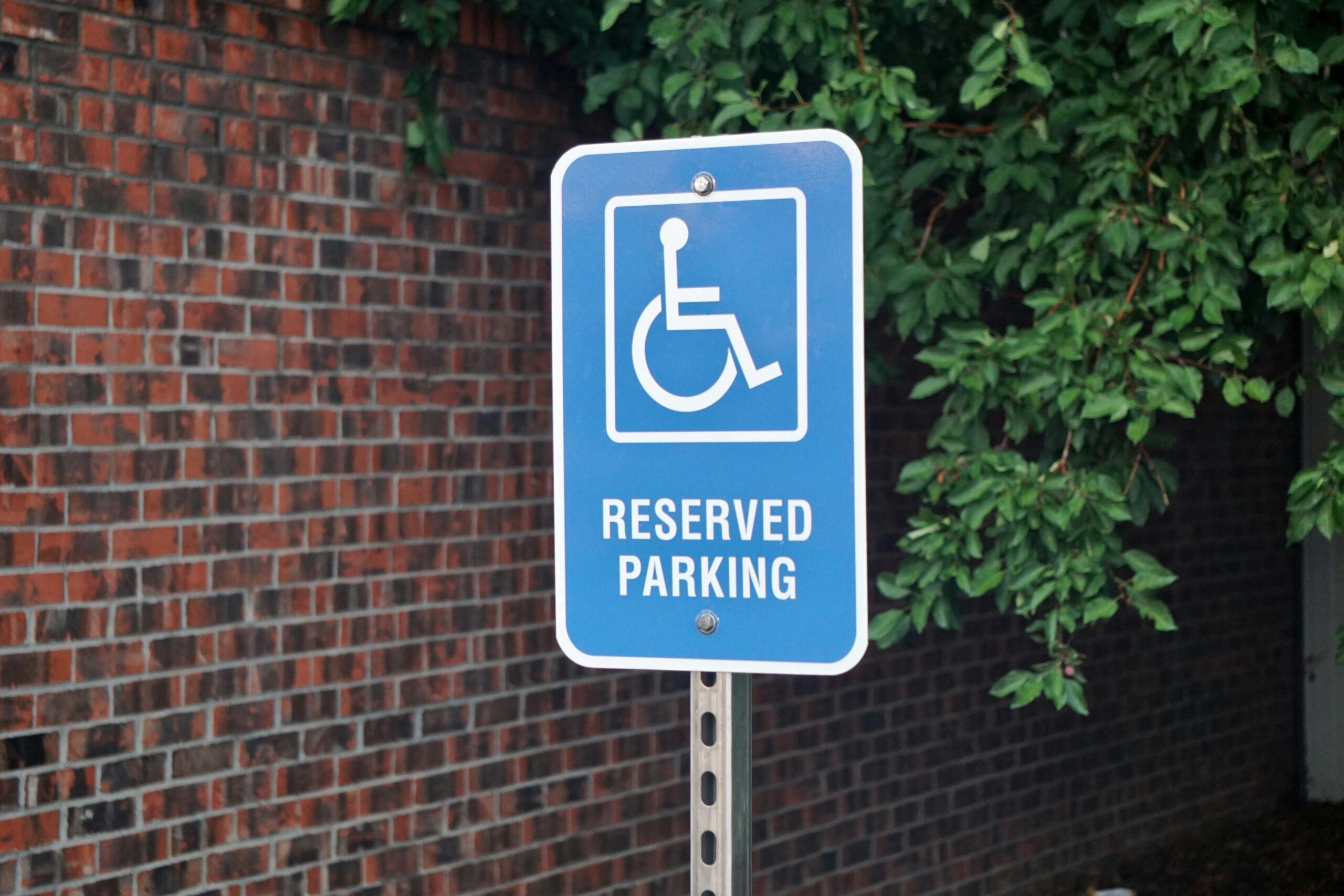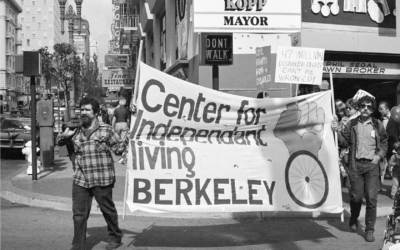(Image: A reserved parking sign shows the emblem of the line drawing of a person in a wheelchair that indicates accessible parking.)
Public accommodations and reasonable access extend beyond just physical buildings. In practice, public accommodations increase access across a wide range of services and facilities, including transportation systems, recreational areas, and communication tools. Accessibility in public spaces means that everyone, regardless of ability, can use and enjoy spaces and services equally. For example, public transportation systems that are accessible to people with mobility impairments make it possible for them to commute to work, attend social events, and live independently. Curb cuts and smooth sidewalks provide access to parks, shopping and schools. And assistive technology increases access to the internet, communications, family, doctors and friends.
Historically, public spaces were not designed with the needs of people with disabilities in mind. Lack of accessibility wasn’t just a design oversight; the truth is that up until recently, people with disabilities were ignored, marginalized, and not considered in the design of spaces and places. The dismissive attitude towards people with disabilities began to slowly shift when soldiers from the Civil War, WWI, and WWII came home from battle with significant disabilities. The first public accommodations were facilities and space where Veterans with disabilities could live and function effectively. By the 1960s, the cry for equality and access for all people with disabilities reached a roar in tandem with the Civil Rights movement. The Independent Living Movement was born, and slowly society became more aware of in support of the needs and experiences of people with disabilities.
As awareness grew and advocacy for disability rights gained momentum in the latter half of the 20th century, the push for accessible public spaces became a key focus. The realization that everyone deserves the same access to public life led to significant legal and societal changes. The political advocacy that resulted from this was not only about securing the rights of people with disabilities to enter buildings or use services, but also about acknowledging their right to be part of the broader community. The passing of the ADA in 1990 codified into law some of these rights, and in the years since, further federal and state accessibility and equity laws have been passed. (see this article about the ADA)
Types of Public Accommodations

A person uses their fingers to read a sign in Braille.
Public accommodations for people with disabilities are essential to ensure that everyone, regardless of their physical, sensory, or cognitive abilities, can fully participate in society. Accessible entrances and exits, such as ramps, elevators, and automatic doors, provide access to individuals using wheelchairs, walkers, or other mobility devices. Accessible restrooms are equipped with wider stalls, grab bars, and lower sinks to cater to the needs of those with mobility challenges. Communication aids, including sign language interpreters, captioning services, and assistive listening devices, create a more accessible environment for individuals who are deaf or hard of hearing, while Braille signs, large print materials, and screen readers assist those who are blind or have low vision.
Service animals are another important aspect of accessibility, as they are allowed to accompany their handlers in all public areas. To learn more about service animals, check out this video, or watch this movie. Transportation systems also contribute to public accommodation, with buses, trains, and other vehicles equipped with ramps, lifts, and designated seating areas. Additionally, paratransit services offer specialized transportation for those unable to use regular public transit.
Public spaces are also designed with accessibility in mind, featuring designated parking spaces near entrances, smooth and level pathways, and emergency evacuation plans that include visual and auditory alarms and evacuation chairs.
In the digital world, website accessibility is addressed by ensuring online services are navigable by screen readers and accessible to users with various disabilities. Adaptive equipment and furniture, such as adjustable-height desks and chairs, have become more common in public spaces, supporting individuals with different physical needs.
Communication channels have also adapted to include telephone relay services and alternative formats like email or text for those with speech or hearing disabilities. Inclusive programming and activities are provided to ensure that recreational programs, classes, and other public activities are accessible to people of all abilities. These accommodations, often mandated by laws like the ADA, create an inclusive society where everyone can access public spaces and services.
Colorado and Public Accommodation Legislation
While significant progress has been made in improving public accommodations, challenges remain. Some public and private organizations and businesses are slow to implement necessary changes, often due to financial constraints or logistical challenges. This ongoing resistance highlights the need for continued advocacy and education to ensure that the rights of people with disabilities are fully recognized and respected.
Public accommodations are not just about meeting legal requirements—they are about ensuring that everyone has the opportunity to participate fully in society. Accessible public spaces mean that people with disabilities can contribute their talents, engage in social activities, and live with dignity and independence. Achieving this vision requires ongoing commitment and action from all sectors of society, including government, businesses, and the community at large.
While federal laws such as the ADA have laid the groundwork for accessibility and inclusion, some states have taken additional steps to expand public accommodations for people with disabilities. Colorado, in particular, has been proactive in promoting disability rights through state-specific legislation, reinforcing and, in some cases, going beyond the provisions of the ADA.

A man with IDD sits at a desk in front of his laptop with headphones on, preparing to work.
One of the key pieces of legislation in Colorado is the Colorado Anti-Discrimination Act (CADA). This law, revised under the Protecting Opportunities and Workers’ Rights (POWR) Act, aligns closely with the ADA but removes the requirement that a disability must have a “significant impact on the job” to warrant accommodations. This shift emphasizes that any reasonable accommodation allowing an individual to perform essential job functions should be provided. Additionally, the POWR Act increases penalties for violations related to discrimination in public accommodations.
Another law is HB21-1110 Colorado Laws For Persons With Disabilities, which mandates that all state and local government websites and digital services in Colorado be accessible to individuals with disabilities. This law ensures that digital spaces, which are now imperative for accessing information and services, adhere to web accessibility standards. By doing so, Colorado is not only improving access for people with disabilities but also setting a standard for digital inclusivity that other states may follow.
Workers’ Compensation Disability Benefits (HB24-1220) is another important piece of Colorado legislation. Effective in August 2024, this law provides additional rights for workers’ compensation claimants with disabilities, such as the right to refuse modified employment if it requires excessive travel or violates medical restrictions. It also increases the caps on temporary and permanent disability payments, ensuring that individuals with disabilities receive fair compensation and protection in the workplace.
Looking ahead to January 2025, HB24-1342, Test Accommodations for Persons with Disabilities, will continue to expand rights for individuals with disabilities in Colorado. This law focuses on professional licensing and certification exams, requiring testing entities to grant accommodations without necessitating a new diagnostic exam if the accommodation was previously granted on a standardized test. This reduces the burden on individuals with disabilities and ensures that they have fair access to professional opportunities.
These Colorado-specific laws demonstrate the state’s commitment to expanding public accommodations and ensuring that all individuals, regardless of ability, have equal access to public life. By addressing gaps in federal legislation and proactively enhancing protections, Colorado is setting a strong example of how states can lead the way in creating a more inclusive society.
What If Your Rights Have Been Violated?
In Colorado, individuals who believe their rights have been violated regarding public accommodations can file a claim through the Colorado Civil Rights Division (CCRD). Here’s how to do it:
- Contact the CCRD: Start by reaching out to the Colorado Civil Rights Division. You can contact them by phone, email, or by visiting their office in person. It’s a good idea to discuss your situation with them to determine if your complaint falls under their jurisdiction.
- Complete the Intake Form: You will need to complete an intake form, which provides the CCRD with the necessary details about your complaint. This form is available on the CCRD website and can be submitted online, by mail, or in person.
- Submit Your Complaint: Once you’ve completed the intake form, you can file your formal complaint. Be sure to include any supporting documentation or evidence that may help your case, such as photographs, correspondence, or witness statements.
- Investigation: After your complaint is submitted, the CCRD will review it and may initiate an investigation. They will contact the business or organization involved to gather more information and may attempt to mediate the situation.
- Resolution: If the CCRD finds that discrimination occurred, they may work with both parties to reach a resolution. This could involve making the necessary accommodations or other corrective actions. If a resolution cannot be reached, the case may be referred to an administrative law judge for further action.
You can find more information and the necessary forms on the Colorado Civil Rights Division’s website or by contacting them directly.
The Future of Public Accommodations
In addition to Colorado’s state-specific laws to boost public accommodations, there is a significant legislative package currently proposed at the federal level, introduced by House Assistant Minority Leader Joe Neguse from Colorado, which was co-created with CPWD. This package is aimed at improving accessibility for seniors and individuals with disabilities across the United States. The proposed bills focus on two important areas: housing accessibility and the efficiency of the Social Security Administration’s (SSA) claims processing system.
First, in the area of housing accessibility, a key component of this legislative package is the Universal Design Tax Incentive Act. This proposal would incentivize the construction or renovation of buildings that meet Universal Design Standards. These standards make certain that residential and commercial buildings are accessible to people of all ages and abilities (read this article about Universal Design). The foundation of Universal Design principles is to create spaces that are usable by everyone, to the greatest extent possible, without the need for adaptation or specialized design. Universal Design benefits not only people with disabilities but also others, such as parents with strollers, people on bikes, or older adults with limited mobility. By offering a tax credit for costs associated with meeting these standards, the bill encourages the development of housing that is not only accessible for people with disabilities, but aging adults, children, parents, and many others.

Social Security Disability Benefits are shown written on a small blackboard
Second, the Social Security Claims Processing Improvement Act addresses issues in the SSA’s claims processing system, which has been plagued by ineffective service and lengthy delays. This bill aims to streamline the process through technology modernization, enhanced training programs, and updates to forms and applications. Improvements in SSA’s processing service and timing would provide the foundational financial security needed for people with disabilities to survive. While this is not a physical accommodation, it is equally as important as it would allow individuals to increase independence and equality in our community, and participate in our communities.
Together, these initiatives represent a major step forward in guaranteeing that people with disabilities have broader access to essential services and housing options, improving their ability to live independently and participate fully in society.
“These legislative initiatives represent significant steps towards ensuring accessibility and efficiency in housing and Social Security claims processing,” said Craig Towler, Community Organizer at the CPWD. “By addressing these critical issues, we aim to create a more inclusive and supportive environment for people with disabilities within housing access and minimize barriers and disruptions to Social Security. These pieces of legislation are proof that through progressive policy we can incentivize positive change to reach the more equal and equitable future we all deserve.”
In addition to these laws, the Colorado Department of Labor and Employment (CDLE) offers guidance and resources related to public accommodations and workplace accommodations. Their work, along with that of organizations like Disability Law Colorado, is essential in educating both businesses and individuals about their rights and responsibilities under these laws.
Public accommodations are not just about meeting the minimum requirements set by federal law—they are about embracing a broader vision of inclusion and equity. Through continued advocacy and legislative action, CPWD and Colorado representatives are working to ensure that all public spaces, whether physical or digital, are accessible to everyone. This ongoing commitment helps build a society where all individuals, regardless of ability, can participate fully, contribute meaningfully, and live with dignity. As we look to the future, the goal is not just to comply with accessibility laws but to embrace the spirit of inclusion they represent. Public accommodations are a cornerstone of this vision, and assuring their accessibility is a vital step toward a more inclusive and equitable world.





